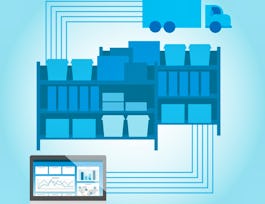Supply chain planning is an important activity in any supply chain. This is where organizations get an idea of the upcoming demand, realize if they have the capacity to meet the demand, and determine how to realize these demands. In this course, we will explore how to use data science to conduct demand and supply planning, how to constrain the forecast, and how to measure the results. As we walk through this process, we will also explore how to use Excel to quantify each step.



Supply Chain Planning
This course is part of Leverage Data Science for a More Agile Supply Chain Specialization

Instructor: Paul Jan
10,151 already enrolled
Included with 
(188 reviews)
Recommended experience
What you'll learn
Describe how demand planning, supply planning, and constrained forecast are associated with one another.
Use Excel to analyze historical data to quantify future needs.
Measure and quantify results for improvement.
Details to know

Add to your LinkedIn profile
4 assignments
See how employees at top companies are mastering in-demand skills

Build your subject-matter expertise
- Learn new concepts from industry experts
- Gain a foundational understanding of a subject or tool
- Develop job-relevant skills with hands-on projects
- Earn a shareable career certificate


Earn a career certificate
Add this credential to your LinkedIn profile, resume, or CV
Share it on social media and in your performance review

There are 4 modules in this course
Welcome to Module 1, Demand Planning. In this module, we will explore demand planning, how to identify influencing factors, how to differentiate between the three simple statistical forecast types, and how to compute a few forecast values.
What's included
2 videos2 readings1 assignment1 discussion prompt
Welcome to Module 2, Supply Planning. In this module, we will discuss the basics of supply planning, how to confirm internal & external capacity, how to confirm material availability, and the importance of communication and data sharing to supply planning.
What's included
1 video3 readings1 assignment1 discussion prompt
Welcome to Module 3, Constrained Forecast. In this module, we will discuss constrained forecasts and consensus meetings. Specifically, we will cover the purpose and creation of constrained forecasts and how consensus meetings are utilized to reach organizational goals.
What's included
1 video2 readings1 assignment1 discussion prompt
Welcome to Module 4, Measure Results. In this module, we will discuss measuring results through collecting actual performance results and calculating forecast errors. Specifically, we will discuss the purpose of measuring results, the types of metrics used when measuring results, and common error measurements and their advantages and disadvantages.
What's included
1 video1 reading1 assignment1 discussion prompt
Instructor

Offered by
Recommended if you're interested in Business Strategy

University of California, Irvine

University of California, Irvine

Rutgers the State University of New Jersey

Rutgers the State University of New Jersey
Why people choose Coursera for their career




Learner reviews
Showing 3 of 188
188 reviews
- 5 stars
68.08%
- 4 stars
20.74%
- 3 stars
5.31%
- 2 stars
2.12%
- 1 star
3.72%
New to Business Strategy? Start here.

Open new doors with Coursera Plus
Unlimited access to 7,000+ world-class courses, hands-on projects, and job-ready certificate programs - all included in your subscription
Advance your career with an online degree
Earn a degree from world-class universities - 100% online
Join over 3,400 global companies that choose Coursera for Business
Upskill your employees to excel in the digital economy
Frequently asked questions
Access to lectures and assignments depends on your type of enrollment. If you take a course in audit mode, you will be able to see most course materials for free. To access graded assignments and to earn a Certificate, you will need to purchase the Certificate experience, during or after your audit. If you don't see the audit option:
The course may not offer an audit option. You can try a Free Trial instead, or apply for Financial Aid.
The course may offer 'Full Course, No Certificate' instead. This option lets you see all course materials, submit required assessments, and get a final grade. This also means that you will not be able to purchase a Certificate experience.
When you enroll in the course, you get access to all of the courses in the Specialization, and you earn a certificate when you complete the work. Your electronic Certificate will be added to your Accomplishments page - from there, you can print your Certificate or add it to your LinkedIn profile. If you only want to read and view the course content, you can audit the course for free.
If you subscribed, you get a 7-day free trial during which you can cancel at no penalty. After that, we don’t give refunds, but you can cancel your subscription at any time. See our full refund policy.

